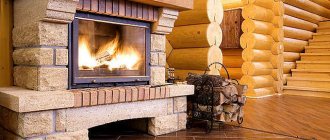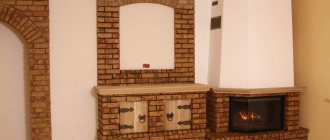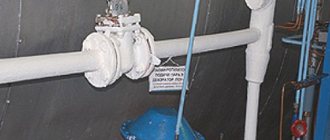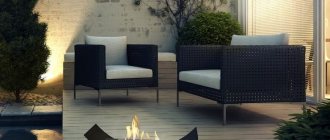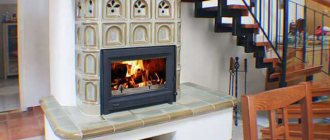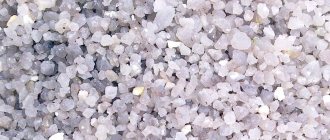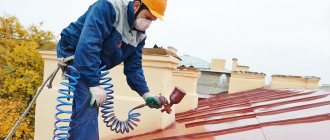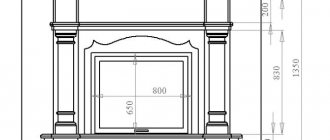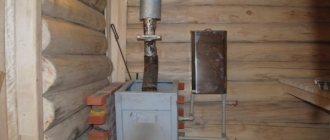Features of heat-resistant paint for stoves and fireplaces
The stove is a structure made of bricks and stones, to which elements made of cast iron (doors, curtains, frames, covers and other elements) are added. If you wish, you can paint the entire hearth, but the choice of paint must be approached responsibly. For example, many of them indicate what materials they are suitable for. But this needs to be checked by clarifying the composition and properties of the paint. You probably won’t be able to get by with just one can, since the materials used to lay the stove have different structures, which means that the requirements for the coloring composition will be different.
Any varnish for a brick stove contains silicone or silicon. Paint for fireplaces and stoves must withstand temperatures up to 600 degrees, but some manufacturers claim that their compositions do not lose their properties even at 700 degrees. These indicators are quite suitable, since the combustion temperature of wood is 300 degrees. Only coal is capable of heating up to a temperature of 900 degrees, but it will only be observed on the surface of the material, and much less heat is transferred to the walls of the furnace. For this reason, it is important to study the composition of the paints, because it will be necessary to use several solutions at once to paint several different parts of the structure.
If the fireplace is located outdoors, then it is necessary to use paint with high anti-corrosion properties - this will prevent the appearance of rust due to exposure to moisture. However, it must be taken into account that products for concrete and metal contain different components. You can also use universal thermal paint, which can be used to coat various materials. It forms a thin film on their surface that protects them from moisture, air and other factors that lead to rust.
The most spectacular colors for a fireplace
Equipment for powder painting of the furnace.
Although the surface of a brick oven is quite dense, after drying latex paint retains its elasticity, preventing cracks from occurring. A fireplace in a private home or country house, like a stove, is a striking element of the interior. Therefore, painting or plastering these structures requires maximum responsibility.
If you are painting a fireplace, silicone paints are suitable. Aerosol paints are especially convenient. To dilute silicone paints, solvent 646 or turpentine is used. To correct the color to the desired shade, you can add dry gouache. To do this, liquid gouache is pre-dried and then ground into a fine, homogeneous powder.
What are heat-resistant paints for?
Thermal paints are able to protect materials at high temperatures. Organosilicon-based compositions are good. They are also used when painting heat exchange equipment or heating equipment, the temperature of which is higher than that of the furnace walls.
The properties of paints can change when different components are added to them. For example, organic resin increases the drying time of the product, thereby increasing its elasticity and the degree of adhesion to the walls of the lesions.
Applying paint
Painting fireplaces requires preparation, just like any other construction work. First you need to make sure that you have purchased exactly the composition you need.
You also need to prepare the following tools:
- soft cloth;
- sandpaper;
- water;
- brush;
- roller;
- copper sulfate solution;
- sulfuric acid solution;
- spray.
First, prepare the surface that will be painted. It is cleaned of dust and dirt. Metal parts are cleaned with fine sandpaper. Be sure to remove greasy stains with a soft cloth soaked in a solution of water and salt. Soot can be easily removed with a solution of hydrochloric acid, and rust with a 10% mixture of copper sulfate.
It is recommended to apply the paint to a slightly warm surface using a brush, roller or spray - whichever is more convenient. In total, you need to make 2-3 layers, each of them should be allowed to dry thoroughly before applying the next one. The fireplace must be allowed to dry for several days; it cannot be used until the paint has completely hardened.
Rating of the best paints on today's market
The need to paint stoves, brick chimneys and fireplaces is quite common. Demand creates supply, so in stores you can find many compositions suitable for this purpose from Russian and foreign companies.
From the outside, an ordinary brick oven heats up to 60-90°C, and a sauna oven – up to 110°C. The temperature of the hob and combustion door can reach up to 400°C when heating with wood and up to 700°C when heating with coal. Therefore, the space near them can heat up to 140°C.
Thus, the paint that will be used to paint the stove must withstand temperatures up to 140°C and adhere well to brick or concrete. The above rating includes well-established and frequently sold brands from both well-known and poorly promoted manufacturers.
1st place – Elcon (varnish)
Special varnish from a well-known Russian manufacturer of heat-resistant paints. The appearance of the treated surface, depending on the number of layers, can be from matte to semi-glossy.
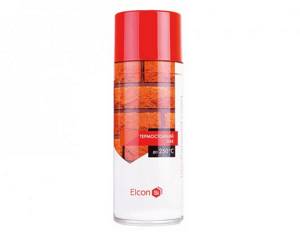
One can is enough for approximately 2 m2 of brickwork. For a standard size oven when painting in 1 layer, 2 of these sprays are required
Specifications:
- color: transparent;
- maximum temperature (°C): 250;
- packaging: spray can, jar;
- displacement (l): 0.52 (can), 0.8 (can);
- gloss: matte or semi-gloss.
Drying time is 3 hours, and for complete polymerization 3 days at room temperature are enough. The recommended number of layers is 1-2. Product consumption is 120-150 g/m2 for metal and up to 200 g/m2 for not very smooth brick.
The product is not demanding on application conditions. Work can be carried out at low temperatures and at high (up to 80%) relative humidity.
2nd place – Elcon (paint)
Russian-made paint often found on the market. One of its significant advantages is the possibility of machine tinting and achieving almost any color.

Black paint can withstand the highest temperatures (up to 1000°C). Then there are the color options: gray, gold and copper (up to 700°C)
Specifications:
- color: 250 shades;
- maximum temperature (°C): 250-1000;
- packaging: spray can, jar, bucket;
- displacement (l): 0.52 (can), 0.8 (can), 25 (bucket);
- gloss: matte or semi-gloss.
Pigmentation leads to a decrease in the maximum permissible temperature. But for many color solutions it is still quite high (600°C or more), so it can also be used to coat metal parts of brick stoves and fireplaces.
3rd place – Rust-Oleum Specialty High Heat
Universal enamel, with the best permissible temperature indicator among paints in this rating. But it has a fairly high price, since the company enjoys well-deserved respect due to the high quality of its products.
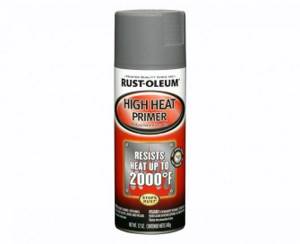
The paint has good qualities - it adheres reliably to the surface and dries quickly. The label and all the information are in English, but you can use the aerosol correctly without instructions
Specifications:
- color: transparent, black, aluminum;
- maximum temperature (°C): 1090;
- packaging: spray can;
- displacement (l): 0.52;
- gloss: matte.
This composition is used mainly for painting metal products, although it can also be applied to brick and concrete bases. This is very convenient, since one product can be used to treat both the walls of a stove or fireplace and very hot metal elements, without having to buy heat-resistant metal paint separately.
4th place – DAP Derusto Heat Master
This enamel is universal and suitable for painting surfaces made of brick, concrete and metal. Made in the USA. It has good quality and a high price.

In terms of its quality, this paint is similar to a higher-rated position, but is characterized by a lower maximum permissible temperature. But for brick surfaces this does not matter
Specifications:
- color: silver, black;
- maximum temperature (°C): 538;
- packaging: spray can;
- displacement (l): 0.52;
- gloss: matte.
Usually one coat is enough for painting, and the drying time is 4 hours. After this, it is necessary to carry out thermal hardening. The paint lasts a long time on the surface and is resistant to physical impact.
5th place – Dufa Scwarzer Peter
High-quality and expensive black enamel from a well-known German manufacturer is one of the best representatives of the “family” of heat-resistant enamels. It is expensive and has small packaging, so it is used only for covering small surfaces.

This paint is rarely used for stoves due to its high cost. But if you need to treat a small area, you can use it
Specifications:
- black color;
- maximum temperature (°C): 140;
- packaging: jar;
- displacement (l): 0.125;
- gloss: glossy.
Dufa products have lower temperature resistance than all other types presented in the rating. Therefore, before using this heat-resistant paint to cover the surface of a brick stove or fireplace, you need to make sure that the masonry does not heat up to temperatures above 140°C.
The paint does not require heat hardening. The interlayer drying period is a day, although usually only a single-layer coating is used.
6th place – Motip
Clear varnish made in Holland. The price is quite high, which, combined with the application of 2-3 layers, makes this product expensive. But the quality of this heat-resistant aerosol is very good.
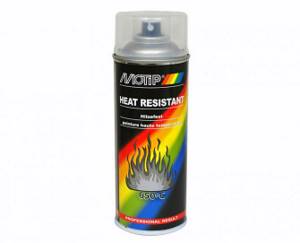
The product under the Motip brand has very high heat resistance, which is not typical for clear varnishes. It can also be used on metal, such as a fireplace grate.
Specifications:
- color: transparent;
- maximum temperature (°C): 650;
- packaging: spray can;
- displacement (l): 0.4;
- gloss: matte.
The drying time between coats is only 5 minutes, and complete drying occurs in 40 minutes - these are good indicators.
In addition to varnish, there is also thermal paint from this company in black and silver, which is also suitable for processing brick.
7th place – Abordage
Made in China, Abordage's heat-resistant spray is used primarily for automotive applications, but can also be used to protect and decorate brick and concrete surfaces.
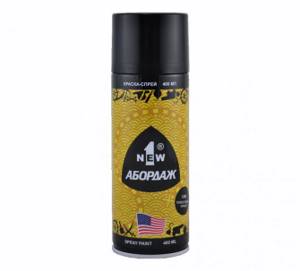
Another paint that is suitable for painting stoves and fireplaces. Does not stand out with any special properties compared to competitors
Specifications:
- color: silver, black;
- maximum temperature (°C): 200-300;
- packaging: spray can;
- displacement (l): 0.4;
- gloss: matte.
This spray produces bright and rich colors, so one coat is usually enough for high-quality coverage. The downside is the lack of heat-resistant color options.
8th place – Decorix
Decorix varnish is one of the most inexpensive heat-resistant paints on the market that can be used to coat stone, concrete or brick.
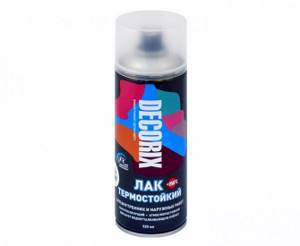
Like most heat-resistant varnishes, Decorix is sold in spray form. This is the most convenient form for applying a protective coating to a flat and large surface.
Specifications:
- color: transparent;
- maximum temperature (°C): 250;
- packaging: spray can;
- displacement (l): 0.52;
- gloss: glossy.
The temperature range at which Decorix varnish can be applied is from +10 to +30°C. Typically, 2-3 layers are sufficient for high-quality surface coverage.
It is necessary to maintain a gap of at least 30 minutes between them. One can is enough to paint an area of 1.5-2 m2.
9th place – Monarca
Spray paint made in China, which can be applied to different types of surfaces.
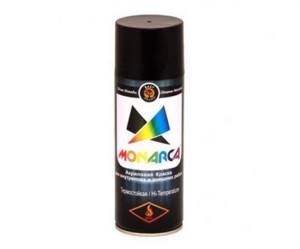
Quite a high-quality product from a brand not very well known in Russia. The high permissible temperature allows you to paint both brick and metal doors of the blower and firebox
Specifications:
- color: silver, black;
- maximum temperature (°C): 600;
- packaging: jar, spray can;
- displacement (l): 0.52;
- gloss: semi-gloss.
Based on an acrylic polymer, this spray dries quickly after application. The total drying time is only half an hour. To harden, you need to heat the brick. The can is enough for 3 m2 when painted in one layer.
Applying paint to metal surfaces
First, the metal elements are cleaned with sandpaper, and the walls of the fireplace are cleaned of dust with a damp cloth. Metal dampers are treated with a 5% sulfuric acid solution and a bristle brush. It is necessary to wear gloves when working with acid. The remaining composition is washed off with a soap solution - first with a cloth, and then with a rag.
Painting the fireplace occurs after it is heated to 150 degrees. Then, within one and a half hours, apply a solution of sodium hydroxide (50 g/l) using a sprayer. Then the fireplace should stand for a couple of days. When applying paint to a warm surface, do not use a brush. If the hearth is not built very correctly (for example, the masonry is uneven), then the surface must be plastered with lime-gypsum mortar in several layers, after preheating the oven to 150 degrees.
When painting, it is important to remember the safety rules: work with gloves and only in a well-ventilated area. It is also necessary to avoid contact of paint and other products with skin or eyes.
Preparing the furnace surface for work
When painting a stove, the first thing you need to do is prepare its surface for painting. A stove with new masonry does not require any special operations, only cleaning from dust. If the stove is plastered, pay attention to the thickness of the plaster layer.
To clean the surface of the oven you will need the following equipment:
- Metal spatula to prepare the surface and also for puttying;
- Brush for removing remnants of previous finishing.
If the layer of plaster is more than one centimeter, the plaster requires dismantling - crumbling areas are removed, the surface is cleaned using a metal spatula, brush or sandpaper. All cracks and missing parts are covered with lime-clay or gypsum mortar.
After the solution has dried, wipe the surface with a damp cloth, wait for the water to dry and you can apply the coloring agent.
To ensure good interaction of paint with other substances, you can saturate the surface of the stove with a primer before painting it.
Painting a brick fireplace
An important stage of decorative cladding is painting a brick fireplace. Even if a special facing material is chosen during construction, which does not require subsequent putty for durability and a beautiful appearance, it is important to choose the right coating. Properly selected paint or varnish will protect the bricks from destruction and add aesthetics to their appearance.
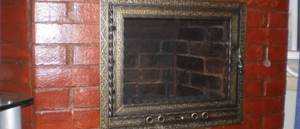
Choosing between paint and varnish
The brick surface of fireplaces and stoves can be treated with paint or varnish. Both options have pros and cons.
Often brickwork has an attractive appearance that fits perfectly into the interior of the room. However, temperature changes, physical impact, and in baths - contact with steam, lead to damage to the top layer. Varnish is able to protect the masonry, leaving its pattern unchanged.
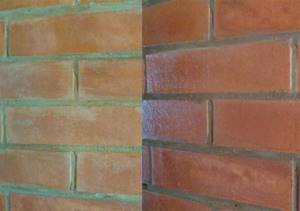
The surface treated with varnish takes on a “wet” tint. Therefore, the pale red color of the brick will become more reddish, and the white grout will become gray.
The varnish can be applied to the entire surface at once. This allows you to get the job done quickly and easily. When painting, if you use enamel and you need to preserve the masonry pattern, you will have to use a stencil and cover the grout, which is extra time and extra effort.
In addition, the varnish immediately helps to cover not only the brick, but also the masonry joints. This prevents the grout from crumbling due to thermal expansion. If enamel is used for painting, then you need to secure the seams between the bricks with a high-temperature sealant.
In the case when the surface pattern is not important, then paint, as well as varnish, can be applied in a continuous layer to both the brick and the grout. Black enamels are often used for baths, as they are most common in stores.
When painting a stove located in a bathhouse or sauna, it is necessary that the composition, after drying, can withstand the high humidity characteristic of rooms of this type.
The following article will introduce you to guidelines for choosing paint for restoring the external coating of radiators, which we strongly recommend reading.
Why do you need to paint?
One of the modern fashion trends is the presence of decorative elements made of natural stone or brick in the interior. Many designers use the natural look and texture of the material. It looks especially beautiful when building and lining fireplaces and stoves, favorably combining the rough appearance of brickwork and live flames, creating an atmosphere of home comfort.
Simple red brick for masonry is attractive at an affordable price, but its quality often leaves much to be desired, in which case they resort to painting or plastering. If you spend money and purchase a special facing option, it is enough to treat it with a special varnish, which will add richness and expressiveness to the appearance. Reasons to paint a red brick fireplace:
- erosion protection;
- hiding minor defects in masonry and material;
- additional strengthening of the structure;
- aesthetic appearance and rich color.
conclusions
In currently popular interiors - country, chalet and shabby chic, the main highlight is the naturalness of various decorative elements and details. A classic Russian brick stove or fireplace fits especially well into them.
A brick stove is an excellent option for providing coziness and comfort in your home; it will give you the opportunity to watch the picturesque flames and provide warmth to your home. In order for the stove to look decent, it must be painted.
This can be done by choosing any method from the many provided. You can paint the stove with special paint from the store or prepare a composition for the coloring solution yourself. The main thing is that the paint is heat-resistant and durable.
The use of coloring agents for metal and with metallic substances in their composition is not recommended - they are not able to maintain their color and quality at high temperatures.
If you wish, you can make a stove or fireplace yourself, but in this case the question often arises of how to refine the hearth. The easiest way is to simply paint it with heat-resistant paint for fireplaces and stoves. But in order for the structure to retain its beautiful appearance for a long time, as in the photo, you need to choose the right way to paint the fireplace.
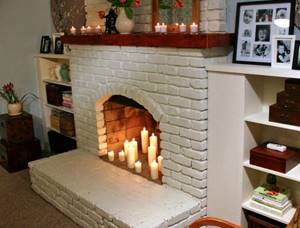
Painting a fireplace: what and how to do it?
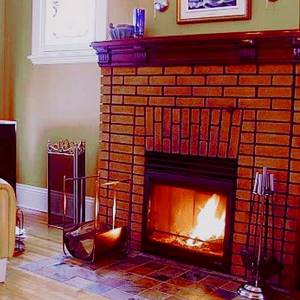
It is no secret that materials lose their original appearance over time. After this, they need to be restored to make them attractive. A fireplace, the surface of which heats up and is destroyed after temperature changes, is no exception. Let's figure out how to prepare the surface for painting, and what paint for fireplaces can be used.
During the repair process, you can change the appearance of the product; on this topic, you can see photos and videos on this topic. Find out the compositions that are used for this work.
Preparing for painting
If the preparation is good, the paint for fireplaces can last quite a long time, otherwise it will simply peel off quickly. This work requires a competent approach, which is where you should start. The base for the coating must be made with high quality:
- When preparing a surface for painting, you may encounter some problems that need to be addressed. First of all, it is efflorescence. This is a crust that forms over time and will need to be removed . This is done using a metal brush.
Attention! When correcting this problem, never use water or try to wash away this damaged layer from the surface. This will only lead to its increase.
- After removing the crust with a brush, you should wait a week, and if the disease does not recur, then you can continue working.
- Use a brush to remove old paint. But you should also pay attention to cracks. They must be processed with a scraper and the material that has begun to lag behind must be removed. After this, the cracks are filled with mortar, which must be made exactly as when doing masonry. It should just be uniform. If the brick was laid on clay, then the putty should be done with clay mortar.
- You will also need to do some seaming. A chisel and hammer are used for preparation. Damaged mortar is simply removed using these tools. If damage to the brick is discovered during the work, it will need to be replaced.
- When you have cleaned the seam from damage, remove all dust from the surface with a brush and then moisten the surface of the coating with water. After you apply a layer of solution, the surface should not absorb moisture from the solution; that is why it is wetted.
- If you use jointing, then it should be done after the seam has not completely dried.
- After restoration of the seams, the product should be allowed to dry for at least three days. This is the time it will take for complete drying. After this, you need to apply a stabilizing solution. It should be applied generously and allowed to absorb. Such solutions exist in different forms, which differ in their composition. Therefore, if an oil-based mixture is used, it should be noted that this is a rather dirty job and it is better to wear safety glasses when performing it. Everything should be processed: both the brick and the seam.
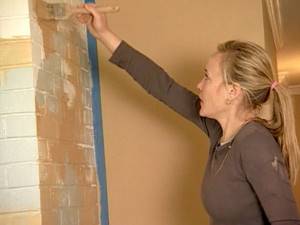
Apply foundation using a brush
- Now we apply the water repellent. This work should be done at a surface temperature of about 50 degrees.
Attention! The water repellent should only be applied to a completely dry surface. If the surface is not completely dry, then the mortar particles will remain under the brick surface, which will lead to subsequent crumbling of the surface. The solution is applied to the entire surface using a brush or roller. Water should not penetrate under the coating layer.
- The water repellent should be applied evenly over the entire surface and generously. If there are drips, it’s not a big deal; they should be removed with a rag.
- The grout for filling joints should not be dry, otherwise it will not last long. Make the mixture homogeneous; there should be no stones in it. To make the mixture, use a drill with an attachment or a construction mixer; these are the tools that will help in preparing a high-quality solution.
Brick fireplace: paint or leave as is?
One of the modern trends in interior design is decorating residential premises with objects made of natural stone or brick that perform a purely decorative function or have a functional purpose. The natural appearance and original structure of these materials look unusual and original. A similar technique is often used in the construction and cladding of fireplaces. The combination of rough brickwork and live flames looks especially beautiful.
Ordinary red brick is inexpensive, but is not always of high quality. To hide flaws in the brickwork and prevent its destruction, they resort to painting. Painting makes the fireplace more well-maintained and makes imperfections invisible. If you choose expensive and high-quality material to build a fireplace, this still will not save you from the need to paint it, since any material during operation at high temperatures eventually loses its original appearance and is destroyed.
Reasons why experienced professionals recommend painting brick fireplaces:
- protection from destruction;
- additional strengthening of the device;
- giving the structure a beautiful appearance and the brick surface a more saturated shade;
- masking minor defects in masonry and material;
- improving the vapor permeability of bricks;
- increasing the service life of the heat generator furnace;
- creating a moisture-repellent coating.
Functions of the paint and varnish coating of a brick heater
Painting a stone heating device is carried out for the following purposes:
- protection of the stove surface from absorbed contaminants, and clothing from brick dust upon contact with brickwork;
- facilitating daily care, that is, maintaining the necessary sanitary and aesthetic condition;
- increasing the decorative design class of the unit;
- adapting the design of the heating device to the existing interior.
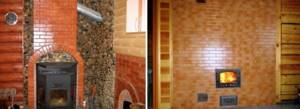
Brick heaters coated with colorless heat-resistant varnish
If the bricklaying was done without sorting the stone by color, then painting the body with a heat-resistant paintwork material (paint and varnish material) of one or more colors will correct the situation. But even a stove finished with face brick is transformed after applying, for example, a colorless paint coating, which gives a richness and matte hue to the stonework.
How can you paint a fireplace?
The choice of paintwork materials for painting this attribute is an important point. When purchasing paint, you must carefully study its composition and properties, since the fireplace is used under special conditions. If you don’t want or have the opportunity to spend money on an expensive coloring agent, you can simply whitewash the heat generator itself. Whitewashing is a way to decorate a brick fireplace on a budget and in an original way.
What properties should the paint have?
If the structure in question is not just a piece of furniture, but is also used for its intended purpose, it cannot be painted with the first paint that comes to hand. The fireplace is exposed to high temperatures, so the paintwork must first of all be resistant to fire, otherwise the coating will quickly crack and begin to bubble.
The outer surface can warm up to 90°C. Not every paint can withstand such a high temperature. If the structure is built according to all the rules, it must transfer at least half of its heat to the room. In addition, the efficiency of the heater largely depends on the type of coloring composition with which the fireplace is coated. A smooth surface has worse heat transfer than a rough surface, so it is better to avoid using aluminum paint and its analogues.
Another important point is the color of the paintwork material. The darker it is, the more intense the heat transfer will be. Among other things, the coloring composition should not emit harmful substances, since fireplaces are usually located in residential areas. All these nuances must be taken into account when purchasing paint, otherwise the result will not live up to expectations.
Suitable types of paints and varnishes, brands
The table provides information about the types of paints for painting brick fireplaces:
Information about some popular brands of paints and varnishes for painting brick heat generator stoves:
Budget options (whitewashing, etc.)
You can cheaply paint a heat generator stove with your own hands using the so-called grandfather’s methods: lime, chalk, clay, homemade coloring agents. These methods have long been used to improve village stoves. A whitewashed or clay-covered fireplace in modern homes looks at least strange, but in an antique-style house or country house such a design will fit perfectly into the overall interior.
How to prepare a fireplace for painting?
Before you start painting, the structure must be properly prepared. Ignoring this procedure will lead to the fact that the paintwork will lie unevenly, quickly crack and peel off. Stages of preparing a fireplace for painting:
- Removing dust, dirt and cobwebs.
- Processing metal parts with sandpaper (it is better to use fine-grained sandpaper).
- Removing greasy stains. This should be done with a soft cloth soaked in saline solution.
- Removing soot with hydrochloric acid solution.
- Getting rid of rust. Rusted areas can be effectively cleaned with a rag moistened with a 10% solution of copper sulfate.
If the fireplace is made of brick of unsatisfactory quality, or there are significant defects on it, it should be plastered in 2 layers with a lime-gypsum or lime-clay composition, and walked over the plastered surface with coarse-grained and then fine-grained sandpaper. After this, the fireplace needs to be heated a little. Paintwork works better on a slightly warm surface. However, you need to make sure of this by studying the manufacturer’s recommendations for using a specific paint.
Seams between bricks: disguise or highlight?
Disguising or highlighting the seams between bricks when painting a fireplace is a matter of personal preference. However, highlighted inter-brick seams give the structure a decorative look and emphasize the origin of the material, and a façade painted with a continuous method looks flat and uninteresting. Transparent, sandy, yellowish-toned paints and even white paints and varnishes are well suited for highlighting seams.
To emphasize these elements, you can use a mixture consisting of equal parts of PF-283 varnish and turpentine. This coating will be transparent and matte. To obtain paint, you need to add dry gouache of the required color to the product.
I hope the recommendations given are quite enough to do the job yourself. The following video will undoubtedly help you understand the above.
Treating the stove surface before painting
The principle of operation of the furnace.
Decorative qualities are of great importance, but some features should be taken into account. For example, a shiny surface is much less able to transfer heat. In this regard, it is better to refuse to cover the stove with glossy paints, for example, aluminum. If the stove is built taking into account all the rules, and there is sufficient thickness of the walls of the fireplace, then the heating of the outer side can reach 80 degrees. This temperature is maintained by many synthetic compounds. These include pentaphthalic paints, nitro paints and others.
As for many oil paints, the basis of which is natural drying oil, during use they darken, especially in those spots that are the hottest. There are many heat-resistant paints on the market that are ideal for painting fireplaces and stoves. The downside is that the choice of colors for such paints is quite limited.
Diagram of the spray gun device.
How is the surface of the stove that you are going to paint reanimated? For this purpose, an ordinary red brick is taken and flour is rubbed from it. Add 10 pre-beaten egg whites and milk to the resulting powder. The resulting mass should have the consistency of thick sour cream.
The next step in the process of restoring a stove or fireplace is to coat the surface with drying oil, which achieves a beautiful dark red hue. You should know that the surface treated in this way will be matte. If you want shine, use synthetic or oil-based varnishes.
Powder painting technology.
To ensure the most decorative appearance of the stove, you can paint the seams between the bricks in a light tone. For example, sandy, yellowish and even white shades work well. You can use a composition such as a mixture of turpentine and PF-283 varnish in a one-to-one ratio. The coating is transparent and matte.
Before painting, stoves and fireplaces are thoroughly cleaned, and the seams are deepened by approximately 7 mm. The oven must first be heated so that the surface is slightly warm. The next step is to wet the surface with water. The solution is applied in two layers. It is assumed that the first layer is liquid, with grouting.
how to paint a brick fireplace
How to paint a brick fireplace, what will best protect the fireplace from destruction and contamination.
In modern conditions, most settlements are gasified. And you might think that the era of stoves and fireplaces is forever a thing of the past.
However, it is not. There is a widespread increase in the popularity of fireplaces and stoves. Moreover, most often, preference is given not to decorative, but to working stoves.
Of course, it is impossible to build a real, working fireplace in a modern apartment. But in your home or country house - it’s quite possible.
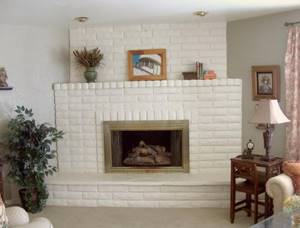
Fireplaces are not just part of the interior. This is, first of all, rest, relaxation after a hard day of work, full of negative emotions.
As you know, living fire has cleansing properties. It is capable of burning negative energy.
Therefore, sit down in the evening in a cozy chair by the fireplace with a cup or glass of your favorite drink. Covered with a soft blanket, admiring the crackling fire in the fireplace, we get rid of tension and anxiety.
This is similar to meditation, only the result is much more effective and stronger. Looking at the fire, we calm down and relax. We relax not only physically, but also emotionally.
Most often, the fireplace is made of fireproof, red brick. And although brick walls are now in fashion, a red fireplace does not always fit into the surrounding interior.
Then a logical question arises: - how to paint a brick fireplace?
Painting a brick fireplace
Many people believe that it is impossible to paint fireplaces and stoves, since such paints do not exist. Actually this is not true.
Modern manufacturers of paints and varnishes have long been producing heat-resistant paints that can withstand fairly high temperatures, up to +1000 degrees.
To paint objects exposed to heat, such as radiators, fireplaces, stoves, chimneys, barbecues, special heat-resistant paints should be used.
Many will ask, is it even necessary to treat objects exposed to high temperatures?
The answer will be yes. Such surfaces must be treated. The fact is that painting surfaces is not only an aesthetic approach.
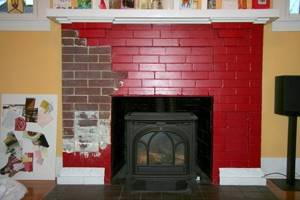
The unique protective properties of heat-resistant enamels protect concrete, reinforced concrete, brick and asbestos surfaces from exposure to high temperatures and moisture.
Heat-resistant paint will not only significantly improve the appearance of any object, but will also preserve the vapor permeability of materials.
Which in turn will significantly increase the service life of the object. When applying paint to a brick base, you should first paint over the connecting seams with a brush.
After this, go over the entire surface with a roller. This could be the end of the article, because we answered how to paint a brick fireplace. However, this will be wrong. In this article we will tell you how to treat a brick fireplace, besides painting.

Heat-resistant varnish for brick stoves and fireplaces
Fireplaces and stoves can be treated with heat-resistant varnishes. Coating a brick surface with varnish is an alternative to painting.
If you want to preserve the texture of the brickwork and at the same time protect it from negative influences, then varnishing is what you need.
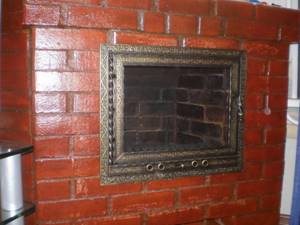
Heat-resistant varnish coating protects the fireplace or stove.
- Protects brickwork from cracking;
- Protects the brick from absorbing excess moisture;
- Strengthens connecting seams and prevents them from fraying;
- Protects against the adhesion of dust and dirt;
- Gives brickwork a beautiful look.
In order to achieve a shiny effect on brickwork, it is necessary to coat the surface with varnish in 3 layers.
Treating iron structures of a stove or fireplace with heat-resistant varnish protects their surface from rust. The varnished surface is easier to clean from dust and dirt.
Which manufacturer to choose
Currently, there are quite a lot of manufacturers of heat-resistant paints and varnishes on the market. Before choosing any company, you should compare prices and read customer reviews.
Pay attention to what surfaces this or that enamel is intended for. What temperatures can it withstand?
I would like to note that it is not at all necessary to purchase heat-resistant paint for the entire fireplace as a whole. Since the higher the temperature resistance, the more expensive the paint.
Make preliminary calculations about how much heat-resistant paint you will need for the surface that comes into contact with open fire.
A surface that heats up less can be painted with paint from the same company and the same color, but less heat-resistant.
Now, thanks to the Internet, you can choose any paint at manufacturer prices. However, when making a purchase, pay attention to delivery methods and costs. And also, to which regions delivery is carried out and to which not.
Homemade ingredients
The main factor determining the requirements for paints and varnishes for furnace devices is their operation at high temperatures.
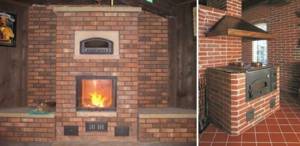
According to the degree of resistance to high temperatures, paint and varnish coatings are divided (in decreasing order) into fire-resistant, heat-resistant and heat-resistant.
Fireproof protective paint for furnaces is used to protect metal components of industrial units from corrosion when exposed to open flames and aggressive combustion products and can withstand temperatures up to 1800 0C. Such materials are expensive, but have not been widely used in everyday life for another reason - their high heat resistance potential when used in home heating devices remains unclaimed.
Heat-resistant paint for household stoves is used to cover metal parts of brick heaters and steel stove bodies. The temperature range for using heat-resistant coatings, depending on the type, is 600 - 1000 0C.
To paint the stone bodies of stove heaters and chimneys (brick, mortar), heat-resistant paint for stoves and fireplaces is used, intended for application to surfaces whose operating temperature is 200-400 0C. In addition to paints, this subgroup also includes varnishes with heat resistance of 250-450 0C.

Heat-resistant coatings in order of increasing temperature resistance - from left to right.
In addition to resistance to high temperatures, heat-resistant paint for stove bricks must have other characteristics:
- safety – when heated, do not release harmful substances into the air;
- sufficient thermal conductivity - do not interfere with heat exchange between the surface of the furnace and the air;
- resistance to household chemicals - maintain physical properties and aesthetics after repeated daily care procedures;
- elasticity – does not form cracks due to temperature changes;
- hiding power - provide a uniform coating when applying no more than three layers.
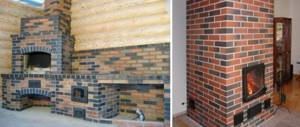
The range of heat-resistant painting compositions offered today by domestic and foreign manufacturers is wide enough to satisfy the consumer’s needs in any situation - whether to give the heater brick a different color that optimally fits into the interior, or to create a transparent protective layer, preserving the natural appearance of the masonry.

Fragments of brickwork painted in various ways
Let's take a closer look at these groups using the example of specific heat-resistant coatings.
These solutions are high-quality mixtures (paints, enamels, varnishes), made on the basis of organic resins and used, depending on the characteristics, both for external finishing work (building facades) and for painting internal interior elements, including stoves and fireplaces.
Heat-resistant organosilicon solutions are used to cover brick stoves (not to be confused with moderately heat-resistant paint, which is used for exterior finishing work and can withstand temperatures up to 100 0C).
Finishing the brick heater body with silicone compounds is a widespread solution due to the affordability of the price range and the following advantages of the material:
- high degree of adhesion to surfaces of any texture;
- strength of the resulting shell;
- moisture resistance;
- durability;
- high heat resistance combined with elasticity (200-250 heating-cooling cycles).
The disadvantage of organosilicon heat-resistant coating is the limited color range of this particular type of solution, due to the chemical composition and place of application.
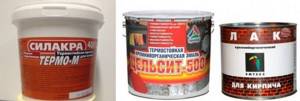
Application to the base is carried out using a brush, roller or spray gun after preparing the surface - cleaning it from dust and priming it with a heat-resistant primer composition, for example, a solution of liquid glass, phosphorus primer or G-77.
Compliance with the instructions for using stove paint on the packaging is the key to a high-quality and durable coating.
This group consists of dispersion (solid in liquid) paints and varnishes made from acrylates, made on a water or hydrocarbon basis.
Both of these types of acrylic mixtures are suitable for painting the brick of a stove or fireplace, but in everyday life water-dispersion paints are more often used, designed, depending on the type, for an operating temperature of 200 - 400 0C.
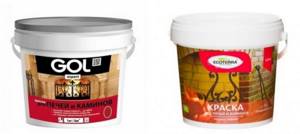
Water-dispersible acrylic painting compositions for stoves and fireplaces
These heat-resistant paints and varnishes penetrate deeply into the pores of the substrate being coated and create a durable film on it, which led to their classification as enamels.
Apply to the surface with a brush, paint roller or spray gun after thoroughly mixing and adding water to the desired consistency, the required number of layers is two, the drying time of each layer is 24 hours, there are no odors during painting.

The color range of acrylic paints is wide, but there are no rich tones, and the effect of adding coloring compounds is short-lived.
We invite you to familiarize yourself with: Do-it-yourself sauna stove lining with bricks
Alkyd emulsions
The root “alkyd” of these paints and varnishes is formed by the merger of two definitions: alcohol and acid (acid).
The required composition of these emulsion (liquid in liquid) paints includes an alkyd varnish, a dye and a solvent, usually white spirit. Depending on the type of paintwork material, the solution may contain marble or granite dust, antifungal and fire-fighting additives.
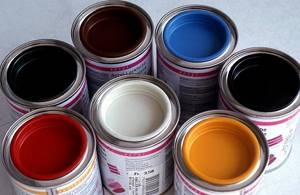
Rich colors of alkyd paint solutions
Alkyd emulsion can be used to coat brick heater housings if the surface temperature does not rise above 100 0C. These paintwork materials will delight you with the variety and richness of colors, but the solution film, hardened after application, is much less elastic than that of acrylic compositions, therefore it does not withstand thermal expansion of the base and by the end of the year of operation it becomes covered with a web of small cracks, requiring replacement of the finish.
The heat resistance of alkyd paints is increased by adding aluminum powder to them, but such compositions are unsuitable for painting brick.
- natural varnish;
- products based on lime and chalk.
To prepare, chalk or lime is simply mixed with water in the proportion of 1 kg of bulk material per 1.5 liters of liquid. The only difference between these compositions is that each subsequent layer of chalk mortar must be applied only after the previous one has completely dried; lime mortar can be painted in several layers at once.
Photo 5. An example of covering a stove with lime composition
It is also recommended to add table salt to the solution at the rate of 0.3 kg for every 2 kg of composition. This is necessary to increase strength, since without any additives the coating will soon simply crumble. Some experts use wood glue (0.1 liters per 10 liters of solution) instead of salt. In this case, the coating may acquire a yellowish tint, which can be eliminated and a classic white color obtained by adding regular blue in an amount of 20 ml.
It is possible to use color additives to achieve a specific shade, but choose based on the area of their use, since some materials may change color when exposed to high temperatures.
The use of chalk and lime compositions is the cheapest way to paint a red brick stove.
A good solution for those who are looking for an answer to the question of how to coat a red brick stove with varnish, but at the same time want to save money, would be to make it themselves. To produce it, you will need chicken egg whites. Don’t be surprised - our ancestors even did stone laying for eggs. But that's not all, there are other components
- squirrels – 8 pcs.;
- milk – 0.25 g;
- brick dust - the quantity is determined independently based on the required color characteristics of the composition.
The whites are beaten with milk and brick dust is added. After painting, the result is an even red color. The decorative layer has good heat resistance and wear resistance.
